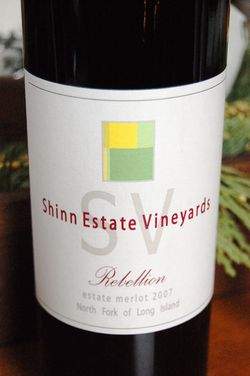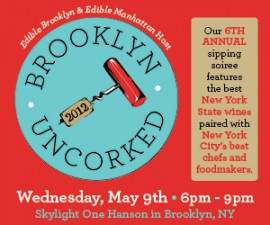Shinn Estate Vineyards 2007 “Rebellion” Merlot
By Lenn Thompson, Editor-in-Chief
 As a category "natural" wines are hot in the wine world, but they aren't necessarily easily defined. Ask ten people what "natural" means and you'll get at least five answers.
As a category "natural" wines are hot in the wine world, but they aren't necessarily easily defined. Ask ten people what "natural" means and you'll get at least five answers.
One common thread, however, is a reliance on naturally occurring, 'wild' yeasts for fermentation rather than inoculating the must with a strain of the winemaker's choosing.
A handful of Long Island producers are experimenting with native yeast fermentations, including Raphael, Channing Daughters, Onabay Vineyards and the makers of this wine, Shinn Estate Vineyards.
Shinn Estate Vineyards 2007 "Rebellion" Estate Merlot ($25) is 100% estate-grown merlot that saw extended time on the skins during a long fermentation by those indigenous yeast. Only 49 cases were made and if you're looking for the super-ripe, forward fruit found in many 2007 Long Island reds, look elsewhere.
Elegant and nuanced, the nose starts with floral and spice notes with ripe red cherry and toasty vanilla beneath. Dried herbs emerge with a little time in the glass, as do chicory coffee aromas.
Bright, crunchy red cherry flavors hit your palate first, with salt-cured meat minerality, spice and floral flavors supporting them. Tasted again about an hour later, more earthy and dried herbs components revealed themselves.
Medium-light in body, the tannins are well integrated and medium intensity and are joined by food friendly acidity. The finish isn't over long, but it doesn't drop off either.
This is a unique wine that may not hit fans of fruit forward wines, but I think it's a fun little foray into "wild" fermentation. And, I enjoyed it enough to include it as one of our wines in the January 2010 New York Cork Club shipment.
Producer: Shinn Estate Vineyards
AVA: North Fork of Long Island
ABV: 13.1%
Price: $25*
Cases Produced: 49 cases
Rating: (3 out of 5 | Recommended)















I’m happy to see more and more of these wines as I think it’s the pathway to true terroir expression.
For the record, Raphael’s use of wild yeast is no longer just an experiment. As of the 2009 vintage all the wines I produce - both red and white - will be made via spontaneous fermentation.
Glad to see that this will be part of this month’s shipment - that bottle will join the 6 we bought last month. Nice wine, curious to see what it’s like 6 months from now.
Rich, how do you draw a line from ambient yeasts to “true terroir expression?” What do the two have to do with each other?
Are you suggesting that the yeast that live on the feet of the fruitflies, on the walls of the crush pad area, and in your vineyard produce a taste that is particular to your vineyards alone? (And that terroir is somehow suppressed by cultured yeasts?)
I recall on this website, now looking back in the Archive, to November 14, 2007. In Response to the post titled “I Guess Alice Feiring Doesn’t Like Long Island Wine…Or Hasn’t Tasted Much of It” as part of Rich’s coment to Alice he says;
“Also, the use of native yeast is entirely overrated and is at times, another one of those movements that are steeped in pseudoscience. Yeast does very little to enhance/change a grapes original, pre-existing characteristics. Actually there is recent research showing that the use of native yeasts can sometimes produce some noxious substances known as biogenic amines, which include such wonderfully named compounds such as putrescine and cadaverine. Needless to say, these compounds in high enough levels can adversely affect the natural flavors and aromas of the grape. The use of natural yeast may also lead to higher levels of acetic acid in the finished wines.
If anything, modern yeast culture has led to a more pure expression of terroir by simply performing better and “staying out of the way.” It’s no coincidence that the development and use of better yeast strains has corresponded to the overall increase in wine quality worldwide. The French have studied this as you can imagine - for decades. Some yeast will slightly influence character early in a wines life but shortly thereafter, it fades and the true grape character will dominate. It always about the fruit, where and how it is grown and the level of fruit maturity. In my opinion, the subject of “natural wines” contains as much, if not more, of the type of hyperbole that has clouded the understanding of wine in this country.”
All hyperbole aside you’ve come a long way baby!
Lol! Yes - my comments were in response to Ms. Feiring’s denigration of Long Island wines once again - mainly because they were not “natural” enough for her taste. The hyperbole I was referring to with regard to natural winemaking had more to do with the so-called effects of bio dynamics on wine quality and the determination of the bio dynamic community (as well as Ms. Feiring) to insist that their wines are better.
What I wrote regarding spontaneous fermentation is true - you can get some pretty funky things. The use of commercial yeast (and I’ve used a few) has no doubt led to a higher level of winemaking all around the world. But its more than just the yeast - it’s also about site selection, variety, crop load, sanitation, etc. Most importantly its about passion and how committed one is to producing quality wine, regardless of the exact ideology.
I’ve never been shy about being a student and to keep learning as much as possible about my craft. I still don’t know if using natural yeasts will make a wine any better, healthy or age better - whatever the case may be. But it’s a new direction I wanted to take and so far I’m really pleased with the results. Some of the techniques I’ve been able to implement seem to reduce many of the past potentials problems associated with indigenous yeasts. There is still the need for some sulfur as well as some very tight controls over the fermentation process.
As you can see I definitely changed my mind on this subject - discussions with people like Pascal Jolivet and Katharina Prum at J.J. Prum really opened my eyes to the possibilities. It seems to work well and adds a level of excitement to the cellar and an edge to my wines which I was looking for. I believe the more we as winemakers “back away” from intervening in a wine’s development, the more sincere and unique our wines will be. After 29 vintages, this is where I’m at.
As for Ms. Fiering I hope she will someday understand how special our wine region truly is and begin to appreciate what all of us are passionately trying to achieve.